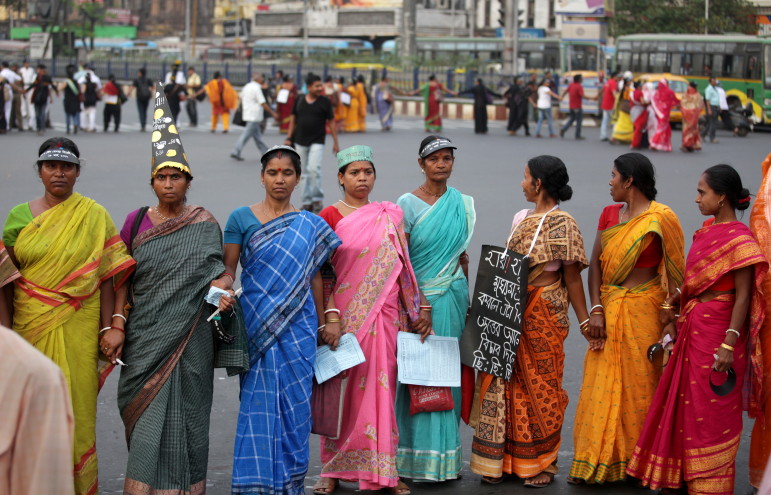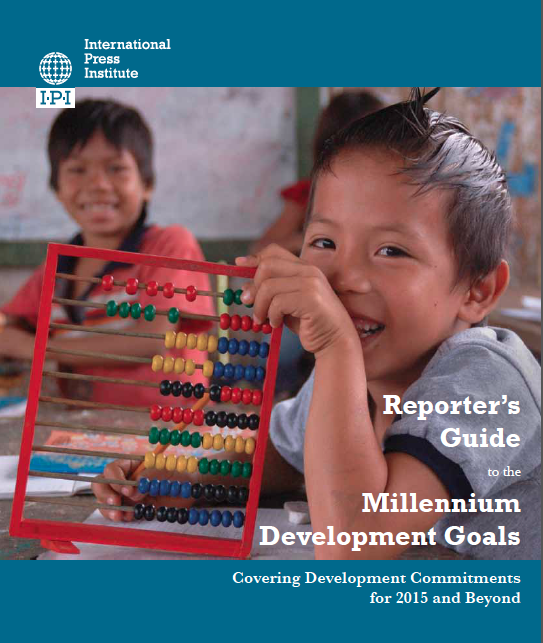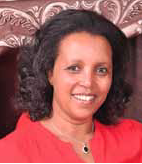

For Whom Does the Flag Wave? Tips on Covering Gender Equality
 Part 8 of a series GIJN is excerpting from the Reporter’s Guide to the Millennium Development Goals: Covering Development Commitments for 2015 and Beyond, published by the International Press Institute.
Part 8 of a series GIJN is excerpting from the Reporter’s Guide to the Millennium Development Goals: Covering Development Commitments for 2015 and Beyond, published by the International Press Institute.
Although egalitarian societies with a pattern of matriarchy still exist in Asia, Africa, the Americas, and Oceania, the decline of matriarchal societies in the world has made way for patriarchal domination. Gender discrimination has become rampant. World history is, indeed, “his-story” and not “her-story.”
The way we live today is influenced by, and based on, male-derived principles, which bring about male dominance and universal patriarchy. No matter where women live, they do not share equal rights with men. Sensitive and justice-seeking journalists should expose this social malady at every opportunity, so that the lives of women can improve.
Since most societies are unwilling to change the status quo, it is not easy to expose gender inequality without ruffling some feathers or provoking outrage. In order, then, to devise the best approach to report on it, we offer a definition and identify related problems:
What Is Gender Inequality?
It is the unequal treatment of a person based solely on that person’s sex. Gender equality does not, however, mean that men and women are the same. Nor does it mean that only women should be protected. It means that both men and women should have equal opportunities, lest reverse discrimination be committed.
Where Do We Find Gender Inequality?
The problem is real in every society, though the degree may vary. In many countries, substantial gender disparity exists in political power, economics, and many aspects of everyday life. Even in technologically advanced societies that champion democracy and human rights, women are discriminated against and abused.
In many Islamic countries whose legal systems derive from Koranic precepts, women are denied equal status when it comes to divorce, inheritance, child custody, and even in transmitting citizenship rights to their children. In Asia, particularly in India and China, new technologies are used to promote the birth of boys, which exacerbates discrimination. In addition, mortality inequality has been observed extensively in North Africa, Latin America, and Asia.
Gender inequality is reflected even in journalism. With the exception of some countries where women enjoy equal privileges with their male counterparts, female journalists elsewhere are oppressed. They are not allowed to practice their profession to the full and are paid less than men for the same position and performance. When female journalists fight for their own rights, besides being inspirational to others, they will increase their own number. In doing so, they will take more journalists on board for the unified fight against gender inequality.
Problems in Brief
1. Equal Pay
In many countries, situations where women are paid less than men for doing similar jobs, simply because they are women, are common. Even in countries like the United States, where laws have been passed to amend wage discrepancies, the difference in salaries stubbornly remains. Discrimination in hiring, firing, and promotion persists. The wage gap, due to the undervaluation of jobs typically thought of as “women’s work,” is still there.
2. Inequality in Healthcare
Statistics shows that women in sub-Africa are more than 1.5 times as likely as men to contract HIV. Women have less access to healthcare facilities compared to men. High mortality rates for women in some parts of the world could be the result of gender bias in healthcare and nutrition. Various studies show that women consume fewer calories per day than men, and this nutritional deprivation impacts growth and has consequences for women with risk factors in pregnancy. This condition complicates childbearing and results in elevated numbers of women and infant deaths. In some traditions, women eat last and least, even when pregnant and breastfeeding.
3. The Right To Vote and Political Empowerment
Although limited voting rights were gained by women in Sweden, Britain, and some U.S. states in the 19th century, the right to vote for women is not yet widely achieved. In general, women are defined by deeply rooted cultural values only as mothers, wives, and daughters. Another stereotype is the gender-gap theory, which contends that men are more interested in politics than women. The absence of women in political, social, and economic life has created imbalances in decision-making structures.
4. The Right to Equal Education
Educating women as a key to development and the reduction of poverty is widely accepted. But there are many reasons to be concerned about existing gender inequalities in education where girls are less likely to have access to school. While there are extreme cases, like in Afghanistan, where girls were excluded from schooling altogether, in many countries girls’ education is far from being a priority. Gender-based discrimination against women and girls remains prevalent in many societies. Education, therefore, must be an integral part of any strategy to address gender inequality.
5. Economic Rights
Discrimination against women by granting credits or personal loans on the basis of gender is another reality which hampers participation in economic growth. In many countries, creditors can ask a woman to apply in her husband’s name or deny her altogether. In rural areas where land is a basic necessity for economic survival, ownership of land through inheritance is denied to women.
6. Equality for Development
Women’s participation is central to development, and the exclusion of women in key posts hampers progress. A society that excludes half of its talent pool and work force hurts itself; the extent of a society’s development is most clearly reflected in the freedom women enjoy, and the extent to which they are able to express their creativity. That is why gender equality is universally recognised as a fundamental human right and is included as one of the Millennium Development Goals (MDGs).
Tips for Covering Gender Equality
Reporters willing to expose gender inequality have to find a smooth way of doing it, yet without being fearful, confrontational, and graphic. The practice of this aspect of journalism needs wisdom, particularly in parts of the Middle East, Africa, and Asia, where men who consider the place of women to be in the house become furious whenever gender inequality is discussed.
It is obvious that good journalists should challenge the status quo in existing social political systems and institutions. This they have to do to enlighten and educate those who are willing to learn and advance the cause of women. They have to promote women’s rights, and combat discrimination and domestic violence against women. Good journalists should not only expose gender inequality, they should also provoke a public discussion about it, and continue making it an issue until equality is enshrined in the constitution or bill of rights and in manifestos of both public and government institutions. Indeed, journalists, besides merely covering gender inequality, should promote it as part and parcel of the fight for human rights and insist that change take place.
1. Promote New Heroes
A reporter may find female heroes of the past in each conservative society that oppresses women, portray those heroic women as role models of excellence, and state how all women could achieve highly if they were given an opportunity and the liberty to act like those exemplary women. In extreme cases of fundamental religious societies, where men dominate women absolutely, a reporter should also depict in a positive light the achievements of females in culturally similar yet relatively more progressive countries.
For example, the modernizing measures of former Turkish president Mustafa Kemal Atatürk, who granted women equal status with men, should be portrayed as a positive example when dealing with the Muslim world. Indeed, for those who are skeptical, demonstrating the fact that marriage and motherhood can go along with the economic participation of women can be an asset.
2. Join Hands To Fight Inequality
Both male and female journalists have to apply cleverness to keep alive the question of gender inequality. The socially and politically conscious journalist can always report on the state of women by choosing particular themes such as medicine, law, education, government, and business administration, or any profession for that matter, and throw some light on the status of women in them by provoking discussions that can raise awareness of women, men, and government officials, including members of parliaments or senates.
In addition to moving their pens and lips, far-sighted journalists should cite good examples by finding role-model societies where the indiscriminate and full participation of women have contributed immensely to the betterment of their nations. Successful female stateswomen, scientists, educators, business leaders, writers, poets, musicians, artists, doctors, engineers, lawyers, and journalists should be presented repetitively to inspire and motivate others to follow in their footsteps.
3. Challenge Gender-based Stereotypes
The gender-gap theory is one such stereotype. It perpetuates the (incorrect) idea that men are inherently more interested in politics than women. Thus, one good example of poor reporting would be describing participation on election days as affirming the “gender gap” between men and women, which is now proven wrong. By educating the public, journalists can help in dissolving cultural stereotypes of this kind.
4. Use Every Opportunity
National holidays are ideal opportunities for the smart journalist to voice his/her opinion about gender inequality.
On Mother’s Day, for instance, one can write anything about the status of women, for example, domestic problems, income disparity, socio-political discrepancies, as well as inequalities in education, healthcare, and professional positions. Father’s Day could be used as an excuse to raise women’s issues in light of the advantages men have.
Regarding New Year’s Day, a journalist should question what the following year has in store for women. Does it bring new jobs, social justice, and better opportunities?
On May Day or Labor Day, a journalist may scrutinize whether all working women have a reason to be a part of the festivities. Do women really have a reason to celebrate, considering that they continue to get paid less for doing the same work as men? Do women who are discriminated against in work places because of their gender have anything to do with such days? What have women who retire without any medical and retirement benefits got to do with these holidays?
Independence Day is an ideal moment to make noise about gender inequality. A journalist should undertake a critical review of the notion of independence, liberation, and freedom versus the situation of women. Does this day really stand for women as well? Are women as independent and as free as men? Or are they still abused, dehumanised, oppressed, and exploited? Indeed, genuine journalists should question the national flag itself: Does that proudly waving flag really represent women, or does it wave only for men?
A native of Harar, Ethiopia, Guenet Ayele Gruenberg completed her studies in Harar and Addis Abeba before working as a journalist for Ethiopian Television Network for 10 years. After the fall of the Ethiopian military regime in 1991, she became the publisher of several newspapers in Ethiopia and served as editor-in-chief of the country’s first monthly magazine focusing on women’s issues. Guenet is also the author of two best-selling books on former dictator Mengistu Haile Mariam, now in exile in Zimbabwe. Guenet has four children and currently lives in France.
 Excerpted from Reporter’s Guide to the Millennium Development Goals: Covering Development Commitments for 2015 and Beyond. Agreed to in 2000, the UN Millennium Goals comprise an ambitious agenda to improve quality of life around the world, focusing on such issues as poverty, gender equality, and education. This unique manual, available in four languages, offers journalists practical tips on covering these critical areas as we near the 15th anniversary of the goals. Twenty-one journalists across six continents contributed to the report, including several active in GIJN. We are grateful to the publisher, the International Press Institute, for permission to publish the series, and to the European Press Photo Agency and EFE Agency for permission to publish the accompanying photos.
Excerpted from Reporter’s Guide to the Millennium Development Goals: Covering Development Commitments for 2015 and Beyond. Agreed to in 2000, the UN Millennium Goals comprise an ambitious agenda to improve quality of life around the world, focusing on such issues as poverty, gender equality, and education. This unique manual, available in four languages, offers journalists practical tips on covering these critical areas as we near the 15th anniversary of the goals. Twenty-one journalists across six continents contributed to the report, including several active in GIJN. We are grateful to the publisher, the International Press Institute, for permission to publish the series, and to the European Press Photo Agency and EFE Agency for permission to publish the accompanying photos.












